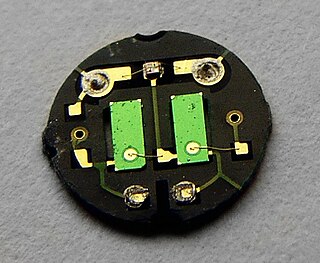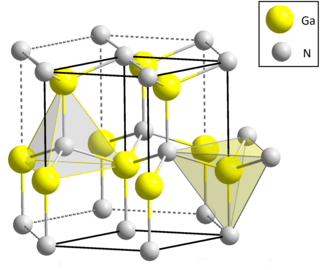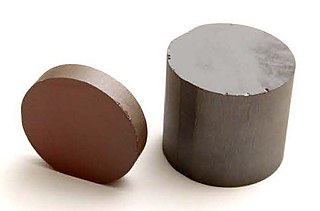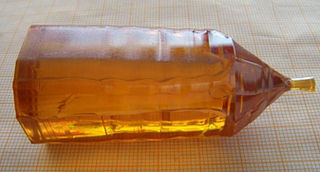
Gallium is a chemical element with the symbol Ga and atomic number 31. Elemental gallium is a soft, silvery blue metal at standard temperature and pressure; however in its liquid state it becomes silvery white. If too much force is applied, the gallium may fracture conchoidally. It is in group 13 of the periodic table, and thus has similarities to the other metals of the group, aluminium, indium, and thallium. Gallium does not occur as a free element in nature, but as gallium(III) compounds in trace amounts in zinc ores and in bauxite. Elemental gallium is a liquid at temperatures greater than 29.76 °C (85.57 °F), above room temperature, but below the normal human body temperature of 37 °C (99 °F). Hence, the metal will melt in a person's hands.

Gallium arsenide (GaAs) is a compound of the elements gallium and arsenic. It is a III-V direct band gap semiconductor with a zinc blende crystal structure.

Pyroelectricity is a property of certain crystals which are naturally electrically polarized and as a result contain large electric fields. Pyroelectricity can be described as the ability of certain materials to generate a temporary voltage when they are heated or cooled. The change in temperature modifies the positions of the atoms slightly within the crystal structure, such that the polarization of the material changes. This polarization change gives rise to a voltage across the crystal. If the temperature stays constant at its new value, the pyroelectric voltage gradually disappears due to leakage current.

The Czochralski method, also Czochralski technique or Czochralski process, is a method of crystal growth used to obtain single crystals of semiconductors, metals, salts and synthetic gemstones. The method is named after Polish scientist Jan Czochralski, who invented the method in 1915 while investigating the crystallization rates of metals. He made this discovery by accident: instead of dipping his pen into his inkwell, he dipped it in molten tin, and drew a tin filament, which later proved to be a single crystal.

A perovskite is any material with the same type of crystal structure as calcium titanium oxide (CaTiO3), known as the perovskite structure. Perovskites take their name from the mineral, which was first discovered in the Ural mountains of Russia by Gustav Rose in 1839 and is named after Russian mineralogist L. A. Perovski (1792–1856). The general chemical formula for perovskite compounds is ABX3, where 'A' and 'B' are two cations of very different sizes, and X is an anion that bonds to both. The 'A' atoms are larger than the 'B' atoms. The ideal cubic structure has the B cation in 6-fold coordination, surrounded by an octahedron of anions, and the A cation in 12-fold cuboctahedral coordination.

Epitaxy refers to a type of crystal growth or material deposition in which new crystalline layers are formed with a well-defined orientation with respect to the crystalline substrate. The new layers formed are called the epitaxial film or epitaxial layer. The relative orientation of the epitaxial layer to the crystalline substrate is defined in terms of the orientation of the crystal lattice of each material. For epitaxial growth, the new layer will be crystalline and will all have a single orientation relative to the substrate; amorphous growth or multicrystalline growth with random crystal orientation does not meet this criterion.

Gallium nitride (GaN) is a binary III/V direct bandgap semiconductor commonly used in light-emitting diodes since the 1990s. The compound is a very hard material that has a Wurtzite crystal structure. Its wide band gap of 3.4 eV affords it special properties for applications in optoelectronic, high-power and high-frequency devices. For example, GaN is the substrate which makes violet (405 nm) laser diodes possible, without use of nonlinear optical frequency-doubling.

Strontium titanate is an oxide of strontium and titanium with the chemical formula SrTiO3. At room temperature, it is a centrosymmetric paraelectric material with a perovskite structure. At low temperatures it approaches a ferroelectric phase transition with a very large dielectric constant ~104 but remains paraelectric down to the lowest temperatures measured as a result of quantum fluctuations, making it a quantum paraelectric. It was long thought to be a wholly artificial material, until 1982 when its natural counterpart—discovered in Siberia and named tausonite—was recognised by the IMA. Tausonite remains an extremely rare mineral in nature, occurring as very tiny crystals. Its most important application has been in its synthesized form wherein it is occasionally encountered as a diamond simulant, in precision optics, in varistors, and in advanced ceramics.

Lanthanum oxide, also known as lanthana, chemical formula La2O3, is an inorganic compound containing the rare earth element lanthanum and oxygen. It is used in some ferroelectric materials, as a component of optical materials, and is a feedstock for certain catalysts, among other uses.

Gallium phosphide (GaP), a phosphide of gallium, is a compound semiconductor material with an indirect band gap of 2.24 eV at room temperature. Impure polycrystalline material has the appearance of pale orange or grayish pieces. Undoped single crystals are orange, but strongly doped wafers appear darker due to free-carrier absorption. It is odorless and insoluble in water.

Bismuth germanium oxide or bismuth germanate is an inorganic chemical compound of bismuth, germanium and oxygen. Most commonly the term refers to the compound with chemical formula Bi4Ge3O12 (BGO), with the cubic evlitine crystal structure, used as a scintillator. (The term may also refer to a different compound with formula Bi12GeO20, an electro-optical material with sillenite structure, and Bi2Ge3O9.)
Lutetium aluminum garnet (commonly abbreviated LuAG, molecular formula Al5Lu3O12) is an inorganic compound with a unique crystal structure primarily known for its use in high-efficiency laser devices. LuAG is also useful in the synthesis of transparent ceramics.

Gallium(III) fluoride (GaF3) is a chemical compound. It is a white solid that melts under pressure above 1000 °C but sublimes around 950 °C. It has the FeF3 structure where the gallium atoms are 6-coordinate. GaF3 can be prepared by reacting F2 or HF with Ga2O3 or by thermal decomposition of (NH4)3GaF6. GaF3 is virtually insoluble in water. Solutions of GaF3 in HF can be evaporated to form the trihydrate, GaF3·3H2O, which on heating gives a hydrated form of GaF2(OH). Gallium(III) fluoride reacts with mineral acids to form hydrofluoric acid.
Gallium phosphate (GaPO4 or gallium orthophosphate) is a colorless trigonal crystal with a hardness of 5.5 on the Mohs scale. GaPO4 is isotypic with quartz, possessing very similar properties, but the silicon atoms are alternately substituted with gallium and phosphorus, thereby doubling the piezoelectric effect. GaPO4 has many advantages over quartz for technical applications, like a higher electromechanical coupling coefficient in resonators, due to this doubling. Contrary to quartz, GaPO4 is not found in nature. Therefore, a hydrothermal process must be used to synthesize the crystal.

Yttrium boride refers to a crystalline material composed of different proportions of yttrium and boron, such as YB2, YB4, YB6, YB12, YB25, YB50 and YB66. They are all gray-colored, hard solids having high melting temperatures. The most common form is the yttrium hexaboride YB6. It exhibits superconductivity at relatively high temperature of 8.4 K and, similar to LaB6, is an electron cathode. Another remarkable yttrium boride is YB66. It has a large lattice constant (2.344 nm), high thermal and mechanical stability, and therefore is used as a diffraction grating for low-energy synchrotron radiation (1–2 keV).

Bismuth silicon oxide is a solid inorganic compound of bismuth, silicon and oxygen. Its most common chemical formula is Bi12SiO20, though other compositions are also known. It occurs naturally as the mineral sillénite and can be produced synthetically, by heating a mixture of bismuth and silicon oxides. Centimeter-sized single crystals of Bi12SiO20 can be grown by the Czochralski process from the molten phase. They exhibit piezoelectric, electro-optic, elasto-optic and photoconductive properties, and therefore have potential applications in spatial light modulators, acoustic delay lines and hologram recording equipment. Bi12SiO20 can be obtained as a whitish powder with band gap of approximately 3.2 eV starting from bismuth subcarbonate and silica in presence of ethyleneglycol. 29Si solid-state NMR is used to proof that the Si(IV) cations are sharing oxygen atoms with the Bi(III) cations. The 29Si chemical shift (δ) in Bi12SiO20 is −78.1 ppm. Unlike the bismuth oxide, the presence of the acidic Si(IV) cations avoid the reactivity with CO2.
The glass forming ability of gallium(III) sulfide and lanthanum sulfide was discovered in 1976 by Loireau-Lozac’h, Guittard, and Flahut. This family of chalcogenide glasses, referred to as gallium lanthanum sulfide (Ga-La-S) glasses, have a wide region of glass formation centred about the 70Ga2S3:30La2S3 composition and can readily accept other modifiers into their structure. This means that Ga-La-S can be compositionally adjusted to give a wide variety of optical and physical properties. Optically, Ga-La-S has a high refractive index, a transmission window covering most of the visible wavelengths and extending to about 10 µm and a low maximum phonon energy, approx. 450 cm−1. Thermally, the refractive index of Ga-La-S glasses has a strong temperature dependence and low thermal conductivity, which results in strong thermal lensing. However, the high glass transition temperature of Ga-La-S makes it resistant to thermal damage, it has good chemical durability and unlike many chalcogenides which are based on arsenic, its glass components are non-toxic. A clear advantage over other chalcogenides is its high lanthanum content which allows excellent rare-earth solubility and dispersion of the ions in the glass matrix for active devices. Ga-La-S can exist in both glassy and crystalline phases, in a glassy phase, it is a semiconductor with a bandgap of 2.6 eV corresponding to a wavelength of 475 nm; consequently Ga-La-S glass takes a deep orange colour. As with all chalcogenides the phase of the bulk is determined by two key factors; the material composition and the rate at which the molten material is cooled. These variables can be controlled to manipulate the final phase of the material.
LSAT is the most common name for the inorganic compound lanthanum aluminate - strontium aluminium tantalate, which has the chemical formula (LaAlO3)0.3(Sr2TaAlO6)0.7 or its less common alternative: (La0.18Sr0.82)(Al0.59Ta0.41)O3. LSAT is a hard, optically transparent oxide of the elements lanthanum, aluminum, strontium and tantalum. LSAT has the perovskite crystal structure, and its most common use is as a single crystal substrate for the growth of epitaxial thin films.

Bismuth titanate or bismuth titanium oxide is a solid inorganic compound of bismuth, titanium and oxygen with the chemical formula of Bi12TiO20, Bi 4Ti3O12 or Bi2Ti2O7

Shaping processes in crystal growth are a collection of techniques for growing bulk crystals of a defined shape from a melt, usually by constraining the shape of the liquid meniscus by means of a mechanical shaper. Crystals are commonly grown as fibers, solid cylinders, hollow cylinders, and sheets. More complex shapes such as tubes with a complex cross section, and domes have also been produced. Using a shaping process can produce a near net shape crystal and reduce the manufacturing cost for crystals which are composed of very expensive or difficult to machine materials.














